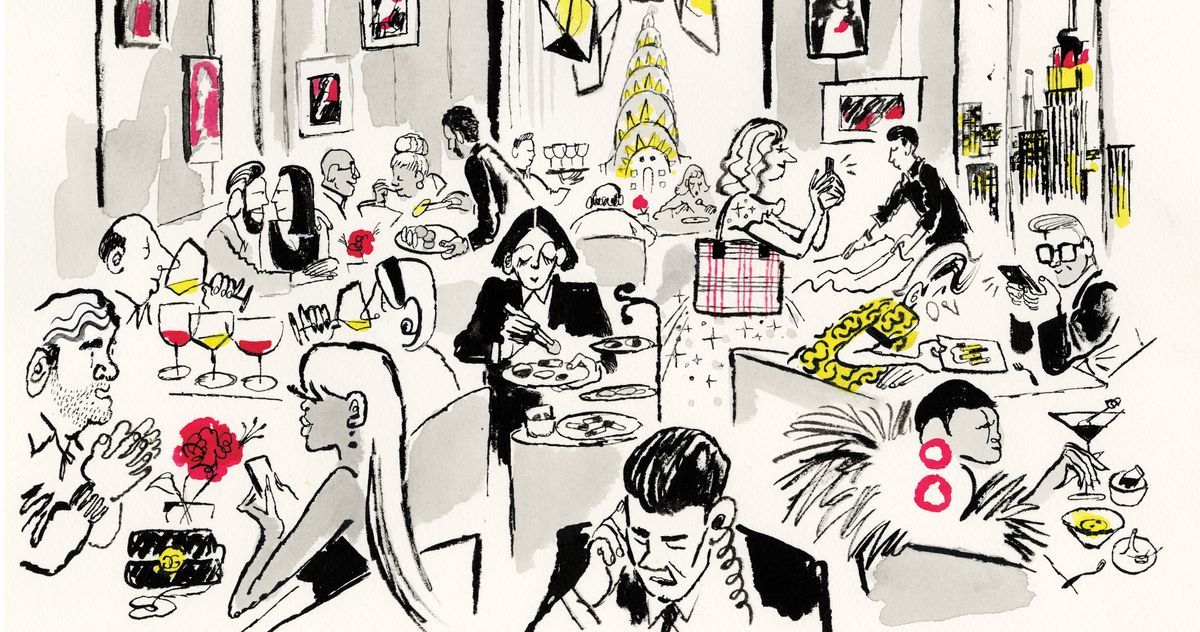Centurion New York Is a Restaurant Only For AmEx Black Cards
This article originally appeared in The Year I Ate New York, a newsletter about eating through the city, one restaurant at a time. Sign up here. The Gallery dining room at Centurion New York on a Wednesday night. Illustration: Lauren Tamaki
Our usual diner-at-large, E. Alex Jung, is away on assignment this week. Filling in is Matthew Schneier, a features writer at New York and the Cut.
It was the celebrity plastic surgeon who clued me in. We found ourselves seatmates at a cancer benefit at Avra, the Madison Avenue estiatorio that serves Greek salads to what remains of the uptown power-lunch elite, and Dr. Andrew Jacono — the architect of faces including Marc Jacobs’s (I am betraying no confidences here: Jacobs is happy to acknowledge his work) — was telling me that the real power spot was Centurion New York. As ladies bid on auction lots like a cocktail party at the Chopard boutique and a four-night stay at a wellness retreat called the Ranch at Palazzo Fiuggi, the good doctor pulled out his phone and texted a well-placed friend. Would the Centurion have me? Doctor, they would.
Entrée was not otherwise guaranteed. New York is once again in a clubby moment, with private hospitality on the rise. The mayor parties at Zero Bond, mostly protected from prying eyes as he dances with Wendi Deng. Casa Cipriani, on the waterfront, hosts Saudi princesses. Casa Cruz, in a Beaux-Arts manse on East 61st, is a London import. The San Vicente Bungalows, soon to take over the former Jane Hotel, hails from L.A. And now here comes the Centurion New York, a mostly private warren of dining rooms, bars, and a “salon” 55 floors up the midtown super-tall One Vanderbilt.
The Centurion is nominally bookable on Amex-owned Resy, although I have yet to see a reservation available. It exists for the more or less exclusive enjoyment of owners of the American Express Centurion card (a.k.a. the “black” card), a mythic status symbol in the expense-account community. For those who spend $250,000, or maybe $350,000, or quite possibly $500,000 a year on their cards — Amex will not confirm the exact number — the Centurion card, for a $10,000 initiation fee and a $5,000 annual membership, offers unparalleled concierge services, at the ready with anything from private-jet bookings to Renaissance tickets, and all the bragging rights come from clanging down a physical metonym of one percent status. There are rumored to be something like 20,000 Centurion cards in the U.S.; an insider speculated to me that it might be as low as 5,000, hedging that even he couldn’t be sure. Amex, again, would not confirm, and membership is by invitation only. “You can call and beg me for it,” Elizabeth Crosta, an Amex vice president of communications, told me cheerfully, “but nothing much will happen.”
Where membership fails, connections succeed. On a recent Tuesday night, I ascended from Grand Central to One Vanderbilt to check in at the ground-floor reception desk. If the Centurion name is familiar, it may be from the 20-plus Centurion lounges Amex operates in airports worldwide (13 of them in the U.S.). Aside from a private hotel bar in Singapore, the Centurion New York is the company’s first foray into non-airport hubs.
As we waited for our entry passes to print, I wondered aloud if our receptionist, a young woman in a bouclé jacket, had been faced with any crashers. “Attempted,” she said firmly. Then the elevator ferried us noiselessly up, and we walked, accompanied by Crosta, into the oasis, designed in haute-hotel style by Yabu Pushelberg, the firm known, unsurprisingly, for its haute hotels. The salon was decorated with photographs by New York legends, many of them on the scuzzier fringe — Nan Goldin, Joel Meyerowitz, Diane Arbus, Tseng Kwong Chi — though the divide between the collection and the collectors was very clear. “I really want you to come to Connecticut,” an older man wearing Ferragamo loafers and a prominent bandage on his face was telling a young guy over expensive wine stems. Even the salon, a narrowish promenade between dining rooms, had beautiful skyline views of the glittering city below. But then, no detail has been left to chance. “Take a whiff of the bathroom,” Crosta told me. “It’s really unique-smelling.” (It’s sandalwood Diptyque.)
My boyfriend and I had been granted an 8:30 p.m. reservation at the Gallery, one of two Daniel Boulud–run spaces within the Centurion. (The Gallery is the formal option, offering five-course or three-course tastings. The Studio, casual by comparison, is à la carte.) I had expected Boulud’s role to be more advisory than actual — not least because the Dinex Group, his company, runs eight full-service restaurants in Manhattan and a number of smaller market-cafés, plus outposts in Miami, Montreal, Toronto, and Dubai, among others — but as we sat at one of two bars for a predinner Carbon martini (dyed as black as a Centurion card with a house-made mix of squid ink and olive brine), confronting the Chrysler at eye level, there was the chef himself, compact and telegenic in his D.B.-embroidered chef’s whites and leather sneakers. “It’s been a long dance,” Boulud said of his dalliance with Amex, one begun before the pandemic. The Centurion finally opened this March. Looking out onto the Chrysler’s Deco spire, Boulud reminisced fondly of a private dinner he’d once cooked among its gargoyles for a French billionaire. From there, he said, you would have gazed directly into here.
Boulud is, effectively, One Vanderbilt’s gastronome-in-residence. Fifty-three floors down from Centurion New York is Le Pavillon, a same-but-different Bouluderie that offers a $135 three-course or $205 six-course set menu of terre et mer. On ground level is a Boulud épicerie, offering takeaway. Lower still is Jōji, an omakase bar, and Jōji Box, for sushi to go. While Centurion is not, at baseline, the most expensive — Jōji’s omakase dinners start at $375 per person, before wine — it is the most impenetrably exclusive. What remained to be determined was how much that exclusivity was merited, in this airport-lounge-outside-an-airport. There, 732 feet above Manhattan, we prepared to fly Centurion’s friendly skies.
Thanks to its restrictive door, burbling soundtrack (Jamie xx was in rotation the night we were there), and low lighting, the Centurion has an almost spalike calm absent from most of New York’s hotter restaurants. It is a club that doesn’t need to advertise its desirability — all of its guests are already members — and so, largely, it doesn’t. For its guests, this is just another of many homes, and the mood, at least among the guests, was luxuriously titan-casual. The tells were there for the spotting — Louis Vuitton sneakers on the guy in the hoodie, a man’s wristwatch roughly the size of an e-reader, the Hermès Kelly bag sitting on one table like an untouched appetizer — but there were no ostentatious celebrities, no buzz of horny possibility. The most imposing notables were the Chrysler and Empire State buildings, both visible at once from a semi-private room in the corner, the latter lit up the color of Champagne. Boulud stopped at one point to chat with a white-haired man at a table near ours who I thought just might be Richard Meier. A passing staffer, attentive to our every need, offered to look it up. No such luck. “The name on the reservation,” she told us, “is Rosenblatt.”
We selected our courses from the $165 prix fixe, bypassing a set menu of five ($225). Foie gras, duck à l’orange, and cheese for me; king crab, lobster in green curry, and a hazelnut chocolate mousse crémeux for George. But that was just the starting point. When the customer — the member — is always right, the world is your huître. Could we add on the sea scallop crudo from the tasting menu? We could. Champagne appeared “by royal edict.” Then an amuse-bouche of carrot velouté with an accompanying chiclet of carrot cake. A waiter, one of many, came by with a bread course, offering a choice of three. “You can have more than one,” he told us. Was there ever any doubt? It came with Bordier butter. “Commercial butter is a six-hour process,” our waiter explained. “This is more like 72 hours.”
The meal, I regret to tell you, was goutily exquisite. (The outlier was the lobster — a little tough.) So much of New York’s restaurant scene has gone trattoria that it felt novel to be confronted again by the squeeze-bottle artistry and complicated architecture that used to define fine dining in the city. “Lightly torched” scallops, dotted with muscat grapes and hazelnut dukkah, were some of the best I’ve ever had, jellied discs of cool, whispering salinity. The lily of king crab gilded with cauliflower and caviar. A tidy little mille-feuille of porcini “lasagnette” with taleggio foam. (Had we ordered that? Remember foam?) The duck, perfectly pink, was draped over a richly reduced gastrique that tasted, in all the most pleasurable ways, nearly of teriyaki.
Eventually, the bill appeared, in its own little black wooden box. Dinner for two, with two glasses of wine: $514.98 before tip. I gave the box my Amex Delta SkyMiles Platinum (annual fee: $250). We got a quick tour of the wine vault, a tasting room with a hydraulic rising table, on the way out. The office of the concierge, where earlier she had sat typing away at member requests under a pair of framed Motherwells, had gone dark. I couldn’t, I confess, bear the thought of a subway back to Brooklyn. We took a Lyft instead, springing for priority pickup, like kings.
Source: Grub Street


